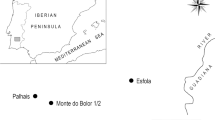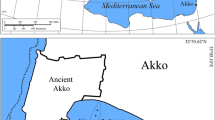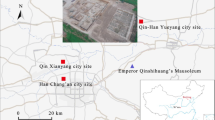Abstract
A wide variety of ferrous arrowheads were in use in ancient India. Several typical chemical analyses of arrowheads found from archaeological excavation carried out at Kaushambi are reported in this paper. The average carbon content of these arrowheads varied from as low as 0.1 wt.% to approximately 0.9 wt.%. Literary evidence for oil quench hardening of ferrous arrowheads, as reported in famous Sanskrit epics—the Rāmāyana and the Mahābhārata—have been discussed in this paper. This type of quench hardening was intentionally adopted as it helped in preventing distortion and formation of quench cracks in arrowheads. The oil quench-hardened arrowheads were rubbed on stones to sharpen them, which also brought about tempering of martensite due to frictional heat.
Similar content being viewed by others
References
K.C. Barraclough, Steelmaking before Bessemer, Vol. 1 (Blister Steel: The Birth of an Industry) (London: The Metals Society, 1984), p. 3.
Vālmīki, Rāmāyaṇa, R.N.D. Shastri, editor, (Gorakhpur, India: Gita Press, 1986).
V.S. Sukthankar and S.K. Belvalkar, editors, Mahābhārata, Critical Edition (Poona, India: Bhandarkar Oriental Research Institute, 1942–1959).
Baladeva Upadhyaya, Sanskrit Sahitya Ka Itihas (History of Sanskrit Literature) (Varanasi, India: Sharada Niketan, 2001), pp. 27, 61.
John Marshall, Taxila, Vol. 1–3, Indian Reprint ed. (Varanasi, India: Bhartiya Publishing House, 1975), p. 107.
John Marshall, in Ref. 5, pp. 547–549.
John Marshall, in Ref. 5, plate 165.
John Marshall, in Ref. 5, p. 536.
R.C. Gaur, Excavations at Atranjikhera (Delhi, India: Motilal Banarasidass, 1983), p. 222.
R.C. Gaur, Excavations at Atranjikhera, (Delhi, India: Motilal Banarasidass, 1983), pp. 422–424.
Satya Prakash Saraswati and Rajendra Singh, Coinage in Ancient India, Vol. 1 and 2 (Delhi, India: Govindram Hasanand, 1986), p. 530.
Monier Monier-Williams, A Sanskrit-English Dictionary, First published in 1899, Indian Reprint ed., (Delhi, India: Motilal Banarasidass, 1990), p. 520.
Vagish Shastri, Personal communication (2007).
Sitaram Chaturvedi, editor, Kālidāsa Granthāvalī (Varanasi, India: Akhil Bharatiya Vikram Parishad, 1944).
Bāṇabhaṭṭa, Kādambarī, J.L. Tripathi, editor (Varanasi, India: K.D. Academy, 1993).
Matsya Purāṇa, Vol. 1–3, published as special issues of Kalyāṇa journal, 58(1) (1984); 58 (1 and 2) (1985) (Gorakhpur, India: Gita Press).
Baladeva Upadhyaya, Sanskrit Sahitya Ka Itihas (History of Sanskrit Literature) (Varanasi, India: Sharada Niketan, 2001), p. 70.
Ramchandra Shastri Kinjawadekar, editor, Mahābhārata with ‘Bhārata-Bhāwadīpa’ Commentary by Nilakaĭtha (Poona, India: Chitrashala Press, 1931).
Monier Monier-Williams, A Sanskrit-English Dictionary, first published in 1899, Indian Reprint ed. (Delhi, India: Motilal Banarasidass, 1990), p. 812.
J.L. Fitzgerald, J. Am. Oriental Society, 120(1) (2000), p. 50.
Baladeva Upadhyaya, Sanskrit Sahitya Ka Itihas (History of Sanskrit Literature) (Varanasi, India: Sharada Niketan, 2001), p. 30.
Katti Shrinivasa Shastri, editor, Rāmāyaṇam-Rāmāyaṇatilaka-Rāmāyaṇaśiromaṇi-Govindarājī-yarāmāyaṇabhuṣaṇetī kā trayopetam (Mumbai, India: Gujarati Mudranalaya, 1919).
Kark-Erik Thelning, Steel and its Heat Treatment, II edition (Oxford, U.K.: Butterworth Heinemann, 1984), p. 144.
R.W.K. Honeycombe, Steels: Microstructure and Properties (London: Edward Arnold, 1981), p. 131.
Kark-Erik Thelning, Steel and its Heat Treatment, II edition (Oxford, U.K.: Butterworth Heinemann, 1984), p. 148.
J.L. Fitzgerald, J. Am. Oriental Society, 120(1) (2000), p. 52.
Author information
Authors and Affiliations
Corresponding author
Rights and permissions
About this article
Cite this article
Dube, R.K. Ferrous arrowheads and their oil quench hardening: Some early Indian evidence. JOM 60, 25–31 (2008). https://doi.org/10.1007/s11837-008-0056-5
Published:
Issue Date:
DOI: https://doi.org/10.1007/s11837-008-0056-5




